The Difference A Front-End Makes
Most of you are too young to remember (but not to appreciate) the incomparable Dinah Washington. Besides managing 7 husbands (not at the same time) over 39 short years of life, she was in my view the best at interpreting the American Songbook. Her torch song standard was What A Difference A Day Makes.
Now that you know how I feel about Dinah…
Let's talk about the difference a front-end makes. I wrote last week that tri bike makers have been doing the very opposite of road bike makers: road bikes have diverged from a single geometry, exploding into geometries of all types, while tri bike makers are coalescing around one geometry.
Let’s consider bikes with a reach of about 425mm. You’ve got a regular traffic jam here, but at 2 different heights. You can see from the graphic below that all these bikes have a reach of between 423mm and 425mm, that is to say, they are practically exactly the same length.
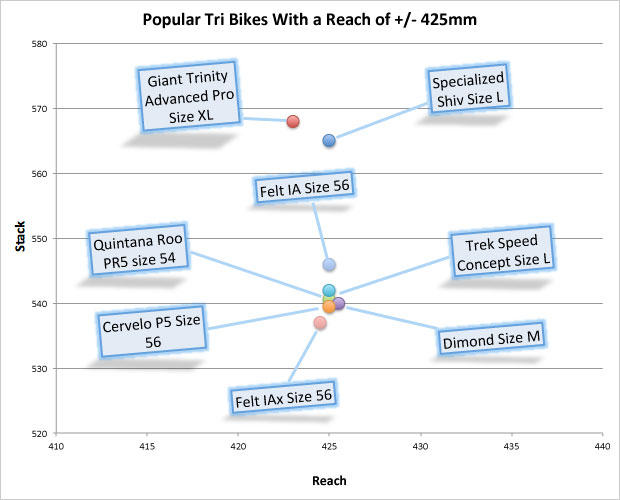
Most are practically the same height as well. Most have a stack of 540mm, and those that don’t have lower or taller stacks to more or less normalize them at 540mm. The Felt IA frame is a little taller than the IAx, but the IA's integrated stem is a bit lower than the IAx's semi-integrated stem.
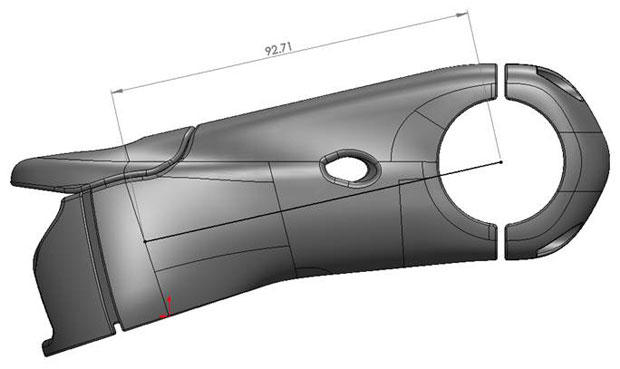
Above is the mechanical drawing for the stem that comes stock on the IAx (IA 10, 16, etc.). The real fit difference between the two IA iterations is in length. The IAx stem has a pure run of about 90.5mm, and Felt’s fully integrated bike has a stem that measures more like 65mm in its run. I have run across people who just found the IAx slightly too long and the integrated IA was just a cleaner fit.
This illustrates the theme here: Front ends can significantly alter the way these bikes fit, even if the underlying frames are almost identical.
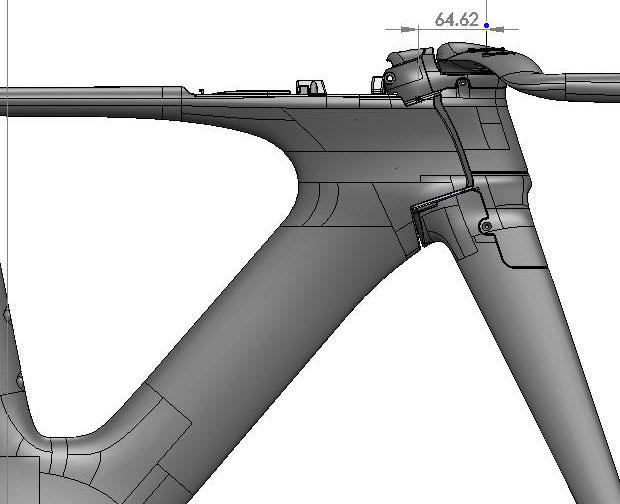
Back to the original chart, highest above, The two frames not almost exactly the same in stack and reach are the Giant Trinity Advanced Pro and the Specialized Shiv, each practically the same length as these other bikes, but between 20mm and 25mm taller.
What is notable about all these bikes? First, look at the sizes. Some are M, some L, some XL, those with numeric nomenclatures are size 56 while another is 54. The take-away here is not to pay too much attention to the named size; rather look at the bike’s geometry (specifically the stack and reach), which are the truth tellers about a frame’s height and length for fitting purposes.
The second lesson we can see from the chart below. All the bikes on this chart have sizing systems that rely on Armrest X and Y, that is, they are superbikes or mostly so, they have integrated front ends, and each of these companies has generated a sizing chart using X and Y from the bottom bracket to the armrest. Note how different the size ranges are even though these bike frames are almost identical geometrically!
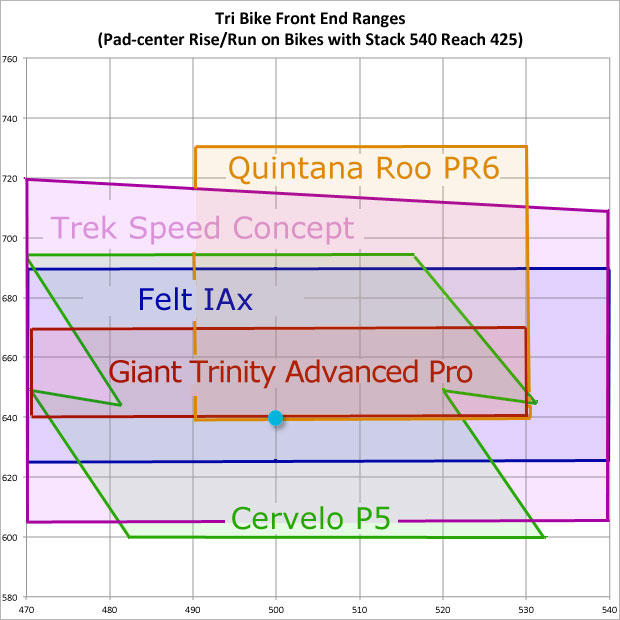
Let me explain how you read this chart above. If you take the Pad X and Y, that is, the run and rise of your position from the bottom bracket to the top of the armrest – and for the purpose of this exercise it’s the middle of the armrest – this Pad X/Y is what the chart above is measuring. Inside of each colored box or area is the Pad X/Y range of each of these bikes.
This chart does not show the entire size run of these bikes. All these bikes are of roughly the same size, just the range of Pad X/Y that this size fits. The bikes in both these charts I've included have frame with a reach of 425mm. As you'll note in the first chart, highest above, these bikes are very similar in their frame geometries, but this chart just above show how differently these bikes actually are from each other in how they fit, because of the wide variations in how their integrated front ends are built.
I'll use myself as an example. My Pad Y and X are about 640mm and 500mm respectively. Do you see that teal circle in the middle of the chart, right where 640mm of Pad Y and 500mm of Pad X meet? That’s me. Happily, I can ride all these bikes. But I’ve brought my pads up a centimeter over the last couple of years because some spinal stenosis, so some of these bikes would have been excluded from consideration were I to ride the position I was riding 5 years ago.
The bike with the smallest range here is the Giant Trinity Advanced Pro. This bike has a fully integrated front end, and even though it is the tallest of all the frames in this series (see the frame stack numbers in the chart highest above) it is the first bike to peter out, heightwise, on this chart. Why is this? I haven’t asked Giant, but I suppose it’s because there is a limit to how high they want their pads to be pedestaled. There is only a 30mm range between the lowest and tallest pad heights per frame size according to Giant’s own fit chart, and in this XL size it's the Pad Y range is 640mm to 670mm. What if you don’t fit inside this range? What if you’re at 630mm? You go to the next size down, Size L. This bike in a Size L has a pad height range of 610mm to 640mm, and so on.
This means that if you want a bike for a pad height of 660mm or 670mm and you want the smallest amount of frame or pad pedestal, the Giant is a very good candidate. But if you need a pad height of 690mm, no can do with this bike.
Notice that the Cervelo P5 has a Pad X/Y range that is just slightly lower and less long than QR’s PR6. This is due to the Aduro stem options. According to its fit chart, and to the best of my ability to parse it, this strange shape in green pretty close approximates the Pad X/Y range and it’s not quite as tall or long as the QR.
Now, the QR PR6, this bike has a stem on it that starts its life average in length and then goes longer. It’s got an integrated stem pretty close in geometry to the stem above that goes on the Felt IAx (see that stem's mechanical drawing above), but then it can be configured higher and longer, higher and longer. If you need a bit of extra length that PR6 is a candidate. If you like the PR6 motif but you need less length (but you still want that frame size) then the PR5 is your huckleberry. It's the same frame as the PR6 but this model accepts a standard stem and so all the range and flexibility of standard stems.
The Speed Concept has the largest range, because it’s got any of 6 stems and each stem can have any of 4 pedestals. This just begins to describe all the fit options available on the bike. Just realize these are the fit options. That high/far stem on an SC, what is the rise and run of that stem, if you did your best to convert it to a standard stem? Could it be 100mm of rise x 50mm of run? I don’t know but that would not surprise me. If you took a –25° stem, that is, a stem that is pointing 8° down from the horizon, and you flipped it upside-down, that stem in a 90mm length atop a 15mm headset top cap would have a rise/run of 94mm and 57mm respectively. The Speed Concept does a very good job of camouflaging a stem geometry that would look pretty funny if constructed on a standard, mortal bike, but it’s great industrial design hides its true metrics.
That Speed Concept with a high/far stem, and with a 45mm pedestal atop it, gives you a lot of height without much length. It’s a strange looking beast so-configured, but if that’s what you need that’s what you need and the Speed Concept, bless its heart, provides it where other bikes don’t.
The PR6, of course, goes even slightly higher. How’s that? Because the stem adjusts tallish, and the Profile Design aerobar on this bike provides for a lot of armrest pedestaling.
The Felt IAx is another bike with a front end that has a range on paper that might not yield an optimal result throughout the range. There is one stem for this bike and all the fore/aft adjustability comes from pushing the extensions and pads foreword and backward, leaving the pursuit bar on place. On the extreme edges this makes the bike a possible fit, but not an ideal handler. There are other, standard stems that work with this bike, but I’d like to see one more production stem in the 50mm to 60mm range.
I wrote sometime back that sometimes (when long and low is required) you must start with the front end and prescribe the bike from the bars back. A very low-profile aerobar on a bike with a stack/reach of 540/425 (Enve and TriRig come to mind) can get you lower than any of these superbikes above. A TriRig
Alpha X on a bike in this geometry yields a Pad Y of 590mm in its lowest undermount config.
Frame metrics are real, they matter, they tell the truth – stack and reach tell the truth – but they don’t tell the entire truth about fit.


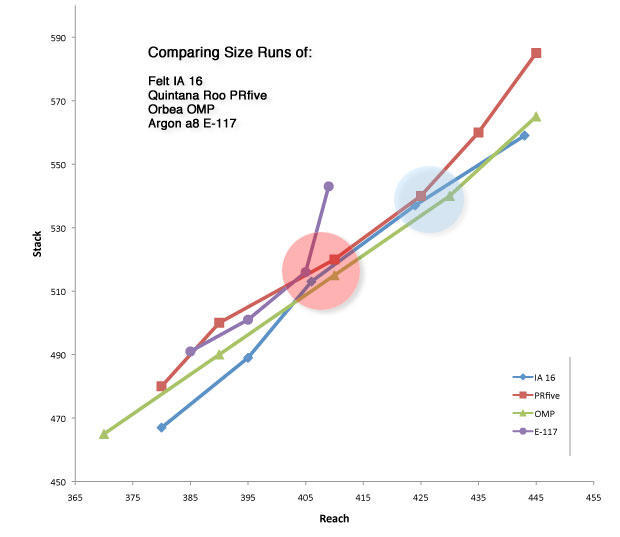
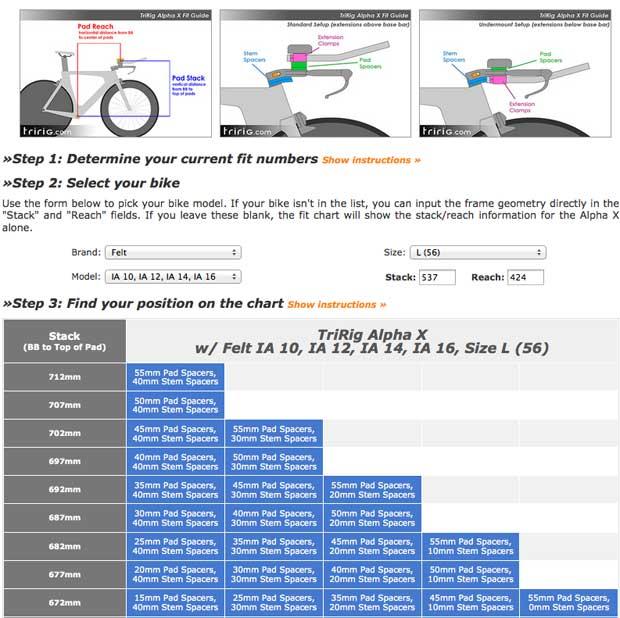
Start the discussion at forum.slowtwitch.com